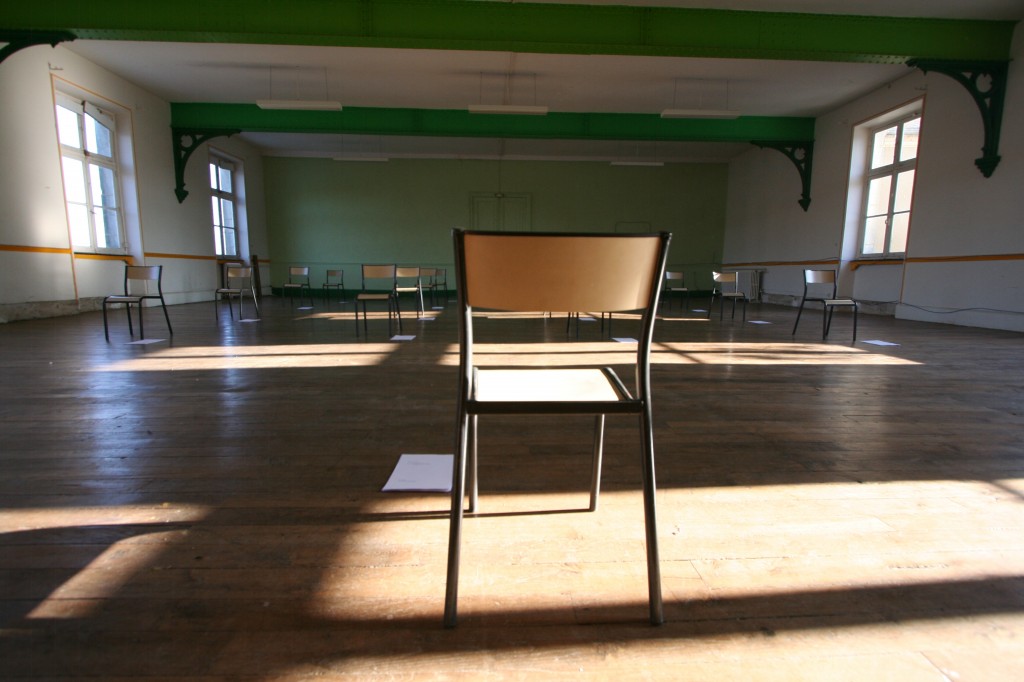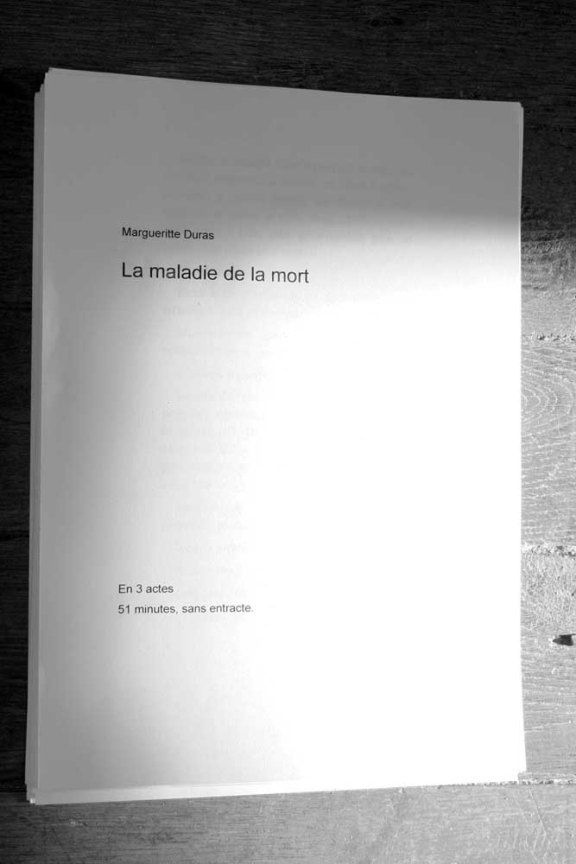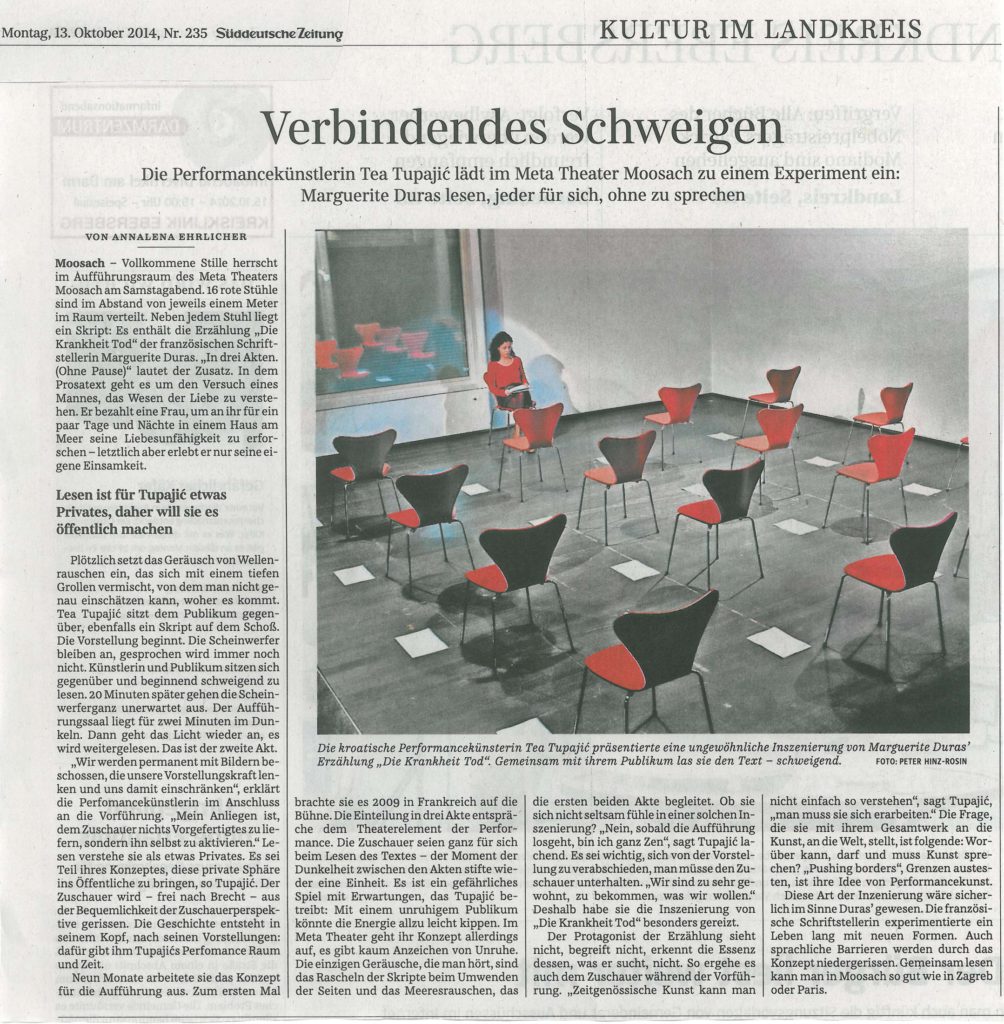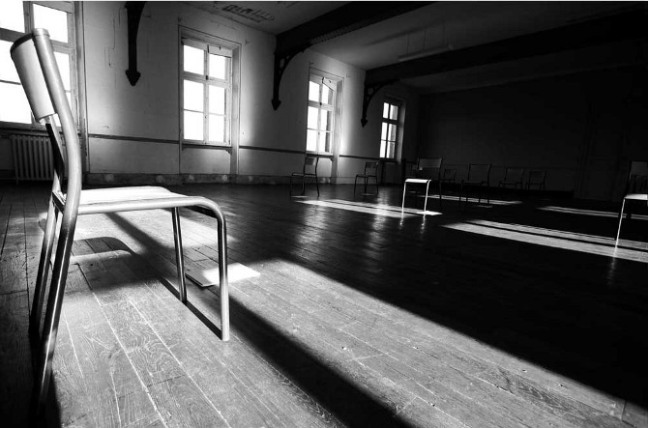Samstag 11. Oktober 2014
1.Vorstellung 18:00 Uhr
2.Vorstellung 19:30 Uhr
3.Vorstellung 21:00 Uhr
Meta Theater, Osteranger 8, 85665 Moosach bei Grafing
Die Performance „La maladie de la mort” basiert auf der gleichnamigen Erzählung der französischen Schriftstellerin Marguerite Duras, die dieses Jahr ihren 100sten Geburtstag feiern würde. Tea Tupajic, Regisseurin und Performerin aus Zagreb, erforscht das Phänomen des leise Lesens, durch das sich eine imaginative Welt eröffnet. Das Publikum ist eingeladen, in die Welt Duras einzutauchen. Die Performance findet in der Einsamkeit des Scheinwerferlichts statt – so zerbrechlich, so anspruchsvoll, so unökonomisch, so unklar. Während der Zuschauer darauf wartet, dass das Scheinwerferlicht erlischt, erkennt er, dass das auf ihn fallende Licht die Vorstellung erst ermöglicht.
Tea Tupajic, geboren 1984 in Sarajevo, studierte Theaterregie in Zagreb. Sie realisierte Arbeiten im Bereich Tanz, Performance und Installation. Von 2010 bis 2012 entstand zusammen mit Petra Zanki das Projekt „The Curators’ Piece“ in dem sie auch die Theaterszene selbst reflektierte. In „Oedipus, my foot“ und „Shakespeake As you like it, a body part“, arbeitete sie als Regisseurin im Kollektiv zusammen mit Künstlern wie Jan Ritsema und Xavier Le Roy. Ihre Arbeiten wurden bei internationalen Festivals gezeigt. Sie ist Mitherausgeberin der Kulturzeitschrift Frakcija.
Tea Tupajic:
”The malady of death” – ”La maladie de la mort” – written 1982 by Marguerite Duras in the prosaic form – aims to be staged in the theatre. It tells the story of nights spent together by a man and a prostitute. Duras uses the verb, the basis of all actions, almost always in the conditional grammatical form, therefore suspending actualization of whatsoever event. The action itself is merely imagined in its vibrating potentiality. Thus making the event nearly impossible and absent, all moving powers of the text shift to the floating, almost unrealistic relationship between the man and the prostitute. Duras’ strategy is very direct. She involves the spectator from the very beginning by putting him on the imaginative stage as one of the characters. It is exactly here where the performative potential of the play lies. When the reading is staged, the text becomes physically close to the reader: he becomes the speaker, he performs in the very here and now. Duras’ text has this wonderful lightness and concreteness and the staged situation its clear simplicity. As we know, there is no author. As we know, there is only the spectator. As we know, the spectator is therefore always the author. But the only way to work from that is to stop working. We know also that the theatre situation is basically very simple: there is the one doing something and the other one who is looking at. However, what if both were to perform the same action, if they were to equally share time, space and therefore the circumstance of the action?

”The malady of death” is a project based on the desire of creating a situation where the performance itself is constructed exclusively through the spectators activity of looking. Looking as an active, intellectual, autonomous and creative act. The performance seemingly absent because happening somewhere else – In the wide spaces of the mental stage. Fragile because so demanding, uneconomical, unclear, the performance that risks not to happen, the performance happening in the solitude of the lights. The performance in which the spectator, while waiting for the lights to go down, realizes that the light which is falling on him is the one enabling the performance to be seen. And it can be seen by doing, not by looking. When reading moves to the public, sharing context of the performance, it requires another type of engagement from the reader. What the spectator can know about the performance is not what the performance wants to teach him, but that what he, through creative act, produces as knowledge. The spectator himself is creating the performance for himself. And this performance created within the performance becomes the private island. We are spending our time by collectively, all at the same time, watching what is presented to us. When participating in the performance not through spectatorship, but performing the act/ivity of reading we are challenged not only to produce the knowledge and the performance for ourselves, but to organize the conditions of that production by mastering and organizing our time ourselves. The field of freedom and labour opened here for the spectator demands from him above all to rethink the way and the act of looking and to examine the blurring positions of the spectator-author-performer that generate as the consequence of the changed way of looking.”

Presse:
Zur PresseseiteSZ, 13.10.2014 – Verbindendes Schweigen


